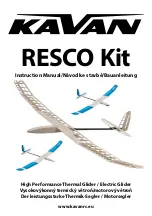
06
50
FREQUENTLY USED KITEBOARDING & WIND
TERMINOLOGY
TRAINER KITE
a kite that may be used on land to simulate the motions used
in kiteboarding. It is an excellent instructional and learning
tool. Despite its small size, this kite still has power, so be
alert.
INFLATABLE KITE
a kite with inflatable tubes designed to float the kite and to
facilitate water re-launchability.
STRUTS
the outer fabric tubes found on your kite. They house the
inner inflatable bladders, which are filled with air to give
structure to the kite.
BLADDER
the inner inflatable tube found within the leading edge and
the struts of the kite. (Imagine a bike-it has both a tire on the
outside and an inner tube which holds air).
FRONTLINE
Security Leach & Relaunch System
QRS-QUICK RELEASE SERCURITY SYSTEM
connection points on the control systems that the pilot may
release in an emergency. QRS Harness Leash (Patent) that is
attached to the rider and kite, designed to disconnect you in
an emergency.
BYPASSTM LEASH SYSTEM
an optional security leash feature that is recommended for
first time users and kiteboarding schools, and for riders who
kiteboard without being hooked into the harness loop.
CONTROL BAR
the steering device the pilot uses to steer the kite.
BRIDLES
the lines that hang from the wing tips of the kite. The flying
lines will be attached from the control bar to these bridle
lines in order to connect control bar to kite.
LEADER LINES
The lines that attach directly to the control bar. You will
attach these lines to the flying lines in order to connect them
to your bar.
FLYING LINES
a term used to describe all four of the lines included with
your kite package. These lines connect the bridle lines on the
kite to the leader lines on the control bar and are typically
20-30 meters in length.
STEERING LINES
the two outside flying lines that attach to the trailing edge
bridles on the kite-one to the left wing tip and the other to
the right wing tip.
DE-POWER LINES
the two center flying lines that attach to the leading edge
bridles on the kite-one to the left wing tip, the other to the
right wing tip. These lines assist in de-powering the kite.
Frontline
HARNESS
a piece of equipment used to temporarily attach the rider to
the control bar harness line. This enables the rider to save
energy by utilizing their body weight and all of their muscles
to hang on to the kite. Most common are the waist harness
(attaches around the torso) and the seat harness (attaches to
the waist and around the legs)
KITEBOARDING
the term used to describe the sport of power kiting on water.
KITESURFING
another term used to describe the sport of power kiting on
water.
NEUTRAL POSITION
This is the position just above the pilot’s head in the sky.
If the pilot levels out the bar, the kite will gravitate to the
neutral position. However, it is difficult and dangerous to keep
the kite in this position. Although in this position the kite
may feel steady and may feel like it has the least amount
of power or pull, it is also the position in which on land the
pilot is most susceptible to lofting. On the water, the neutral
position can be utilized to rest while you reel in your board,
but on land, we strongly suggest you do not utilize the neutral
position. After launching, it is best to make your way to the
water without delay. Do NOT linger on land with the kite in
GLOSSARY
Содержание CROSSBOW 2006
Страница 1: ...2006 U S E R MANUAL CROSSBOW SWITCHBLADE CONTRA REVOLVER CO2 KITE...
Страница 2: ......
Страница 27: ...23 SETUP...
Страница 57: ......




































